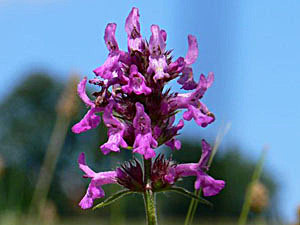
medicinal herbs
Wood Betony
Stachys officinalis

Herb: Wood Betony
Latin name: Stachys officinalis
Synonyms: Betonica officinalis, Stachys betonica
Family: Labiatae
Medicinal use of Wood Betony:
Wood betony was at one time commonly used as a medicinal plant in the treatment of a wide range of disorders, especially as a nervine and tonic for treating maladies of the head and as an external application to wounds. It also stimulates the digestive system and the liver, having an overall tonic effect upon the body. Wood betony is much less used nowadays, and more often forms part of a mixture of herbs. The whole plant is collected when in flower in the summer and can be dried for later use. It is anthelmintic, antiseptic, astringent, carminative, mildly cathartic, cholagogue, digestive, diuretic, mildly emetic, emmenagogue, expectorant, nervine, sedative, sternutatory, tonic and vulnerary. It is taken in the treatment of "frayed nerves", pre-menstrual complaints, poor memory and tension. It can be taken in combination with herbs such as comfrey, Symphytum officinale, and lime flowers, Tilia species, to treat sinus headaches and congestion. Wood betony can be taken on its own, or with yarrow, Achillea millefolium, to staunch nosebleeds. A pinch of the powdered herb will provoke violent sneezing and it has been used as part of a herbal snuff mixture in the treatment of headaches. A homeopathic remedy is made from the fresh plant. It is used in the treatment of asthma and excessive perspiration.Description of the plant:

Plant:
Perennial
Height:
60 cm(2 feet)

Flowering:
June toSeptember
Habitat of the herb:
Grassland, hedgebanks, heath and open woods, avoiding calcareous soils.Edible parts of Wood Betony:
The leaves and flowering tops make a good tea substitute. Refreshing and aromatic, it has all the good qualities of tea without the negative ones.Other uses of the herb:
A fine yellow dye is obtained from the leaves.Propagation of Wood Betony:
Seed - sow spring in a cold frame. Prick out the seedlings into individual pots once they are large enough to handle and plant them out in the summer. Division in spring. Very easy, the plant can be successfully divided at almost any time of the year. Larger divisions can be planted out direct into their permanent positions. We have found it best to pot up the smaller divisions and grow them on in a lightly shaded position in a cold frame, planting them out once they are well established in the summer.Cultivation of the herb:
Grassland, hedgebanks, heath and open woods, avoiding calcareous soils.Known hazards of Stachys officinalis:
None knownPlant information taken from the Plants For A Future.
